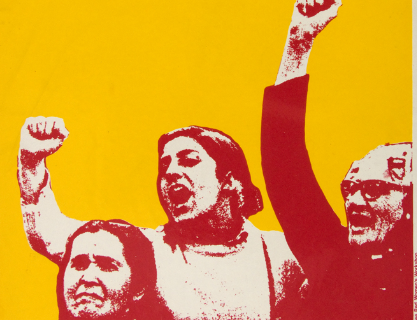
Fresh off the heels of the historic Women's March on Washington, it's clear feminism is having a resurgence. In what is now being called the largest protest in U.S history, some 4 million people from all 50 states and all walks of life took to the streets. Millions more from every continent joined the battle cry: an act of solidarity against inequality of all kinds, not only a fight for women’s rights, but against intolerance towards immigrants, for the health of our planet, and for healthcare. Visually, it was a beautiful sight painted with brush strokes and glitter, creativity, humor, outrage, and hope.
Times of adversity have always triggered a flood of creative outpouring. We decided to take a look back at this phenomena and the stunning protest posters and graphic art created during benchmark moments in the Women’s Rights Movement.

California Women's Suffrage, Bertha Margret Boye, 1911
In 1911, women's suffrage was on the ballot in California, and this was the poster hanging in everyone's windows. Spoiler alert: the measure passed and CA became the sixth state where women could vote equally.

We Can Do It! (Rosie the Riveter), J. Howard Miller, 1942
The famous "Rosie the Riveter" poster was initially commissioned by a company in an effort to motivate workers of both genders. Only in the 80s did the image become an icon for working women and a symbol of WWII's massive impact on women in the work force. It's important to note that the artist wasn't specifically asked to represent a woman in the poster, yet chose to because so many women were working in factories.


"Woman's Spirit", Chicago Women's Graphic Collective, 1975
These posters were designed by the Chicago Women's Graphic Collective. Part of Chicago Women's Liberation, the collective was founded in 1970 in response to the lack of opportunities for artists to communicate feminism. The posters were collaborative efforts to give women artists a voice apart from the male-dominated art world.

Barbara Morgan, 1976
This poster refers to early modern anatomical drawings with a nod to Renaissance era art. Uniting sexuality and science, Barbara Morgan created this poster to critique the scientific male gaze that positioned women as most valuable for their reproductive abilities. The quote is from Emma Goldman (1869-1940), an important anarchist political activist who encouraged women to speak out.

"Take a Pill Mrs. Brown", See Red Women's Workshop, 1976
The See Red Women's Workshop was a group formed by women to combat the negative images of women in advertising and the media. "Take a Pill Mrs. Brown" was a commentary on the way women were treated for mental illness. In the 60s, psychiatrists began prescribing minor tranquilizers like Valium to a lot of wives and mothers who felt dissatisfied with their lives. The drugs were nicknamed "Mother's Little Helper" and women were 70 percent more likely to be prescribed these drugs than men. Feminists, like Betty Friedan, felt these drugs were meant to placate and silence women so they would "not care so much that [their lives] are pointless". See more designs by the workshop here.


"Black Women Will Not Be Intimidated", See Red Women's Workshop, 1980-81
This poster couldn't be more relevant with feminist hero Maxime Waters standing up to Fox News and misogyny as a whole.

"We The People", Shepard Fairey, 2017
Street artist Shepard Fairey designed this poster for the Women's March on Washington. The now-iconic image is based on a 2007 magazine cover photograph of a Muslim-American woman. This image speaks to the importance of intersectionality in feminism. The visual dissemination of this new icon demonstrates that we've entered the next era of feminism for all.
